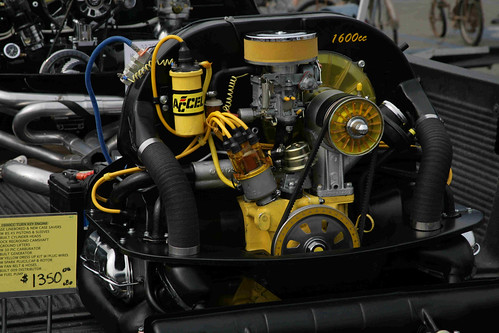
When you press the accelerator pedal on your dune buggy, you open up the butterfly valve inside the carburetor to allow more air into the engine. Usually, this creates more vacuum pressure inside the carburetor which draws more fuel into the engine and causes the engine to turn faster. If you have a centrifugal advance distributor, the ignition timing advances as the engine rpms increase. In some cases, this works just fine, but, in many cases, there is a noticeable "dead spot" in the acceleration response of the engine. This is caused by fact of the ignition timing lagging slightly behind the increased fuel/air mixture entering the engine when you press the accelerator. When that occurs, you also have a drop in vacuum pressure which causes the "stumble" you feel. If you pump the pedal a bit, it tends the minimize the lag, but it's still there, very annoying and potentially dangerous if you're trying to climb a hill or get through a busy intersection.
For some reason, centrifugal advance distributors became very popular some time ago and still remain so to the present day. I suspect it was largely a created demand generated by the marketing department at the manufacturer's headquarters. I can't think of any other reason why this type of distributor became so popular since it really doesn't work very well.
The idea situation would be one where, as the fuel/air mixture increased in volume, the ignition timing would advance right along with it, or even slightly ahead of it. I think of it as either leading with the carburetor or leading with the distributor. That's a simplification, of course, but that is essentially what happens. To put the distributor in the lead, you need to install one with a vacuum advance. There are lots of them available in the used market and there are new ones available in the after-market as well. With a vacuum advance mechanism on the distributor, the above sequence of events is altered. As you press the accelerator creating more vacuum pressure in the carburetor, the vacuum motor on the distributor advances the timing of the ignition simultaneously with the increased fuel/air mixture that is entering the engine. With these two elements working together, the acceleration lag disappears, acceleration increases and, not surprisingly, fuel economy improves.
You would think that this relationship would be intuitive with air-cooled VW engine mechanics, but that doesn't always appear to be the case. It took me a long time to figure out for myself, what should have been obvious from the beginning, but conventional wisdom said that centrifugal advance distributors were simpler and, thus, better and more reliable. It's not true. With the installation of a vacuum advance distributor on my 1776 cc motor along with the 2-barrel progressive Weber carburetor, the power curve is smooth, the acceleration is excellent and I'm getting better gas mileage. I also find that my high-altitude performance is better and that the engine doesn't load up and foul the plugs like it used to.
You probably have an old vacuum advance distributor laying around in your garage right now. Try it, I think you'll be pleased with the improved performance you will experience.




No comments:
Post a Comment